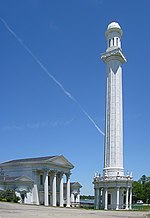Henry French House
Colonial Revival architecture in IndianaFederal architecture in IndianaHouses completed in 1832Houses in Clark County, IndianaHouses on the National Register of Historic Places in Indiana ... and 5 more
Jeffersonville, IndianaLouisville metropolitan area stubsNational Register of Historic Places in Clark County, IndianaSouthern Indiana Registered Historic Place stubsSteamboats of the Ohio River

The Henry French House, also known as the Salmon-French House, is a historic house located in the Port Fulton area of Jeffersonville, Clark County, Indiana in the United States. It was built about 1832, and is a two-story, Federal style brick dwelling with a rear ell added about 1839 to form an I-house. It has some Colonial Revival style design elements.: 2
Excerpt from the Wikipedia article Henry French House (License: CC BY-SA 3.0, Authors, Images).Henry French House
East High Street, Jeffersonville
Geographical coordinates (GPS) Address Nearby Places Show on map
Geographical coordinates (GPS)
| Latitude | Longitude |
|---|---|
| N 38.280277777778 ° | E -85.721111111111 ° |
Address
East High Street 399
47130 Jeffersonville
Indiana, United States
Open on Google Maps







